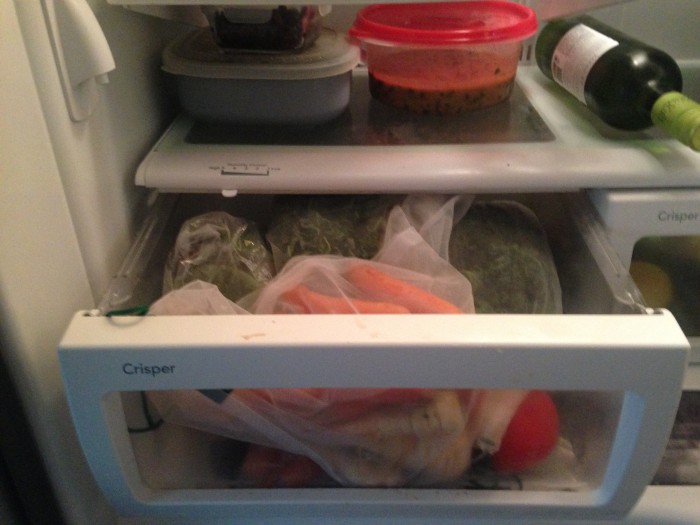The other day, a friend of mine posted a photo on Facebook of the inside of her refrigerator; she did it as part of ongoing work with her nutritionist.
Now, Amy is probably any nutritionist’s idea of the perfect client, a poster child for dietary success — she lost weight, sculpted her body, and took off athletically (total side effect: she also looks gorgeous). She and her husband Matt didn’t just adopt a healthy diet, they embraced food as good fuel, something that powers their lifestyle. They’ve maintained this amazing transformation for YEARS. Yet, I saw the same thing wrong with their fridge as with mine–and most likely yours.
There’s too much food.
 The photo here is the inside of my refrigerator. It’s full of veggies and good-for-me food. But that’s the problem. It’s FULL.
The photo here is the inside of my refrigerator. It’s full of veggies and good-for-me food. But that’s the problem. It’s FULL.
On the day I took this photo, I’d just picked up my box of organic veggies from my local CSA. I worked to fit them all into the bins and shelves, sorting through what we hadn’t eaten, determining what was fit to save.
My husband and I had cooked extra portions to eat for lunch throughout the week, and those containers were filling up space…along with the soup I’d made and random fruits, condiments, bread, and assorted yummies we always stock.
I tossed out the veggies that were past their prime; I cleared out any leftover more than two weeks old; I dumped out the flat bottle of tonic (shhhh; a girl needs a G&T every now and then) to make room for the new, fresh veggies. And that’s the problem.
Americans Waste Shocking Amounts of Food

The Environmental Protection Agency reported that, in 2012, we threw out 35 MILLION TONS of food; that’s three times what we were chucking in the trash in 1960 (and the scary thing about this–Americans weren’t really recycling then, so that ’60s trash included cans, bottles, paper, etc.).
The Food and Agriculture Organization of the United Nations estimates that one third of the food produced for human consumption–some $162 billion in value–is lost or wasted. While a lot of that happens early in the production chain, what we toss out in our homes makes up a significant portion.
I try hard not to waste. My old, soggy veggie bits (along with peels and other cooking waste) go to compost. Uneaten leftovers go into the freezer for another day. We plan meals to use everything in our bi-weekly CSA box (though sometimes, it’s a lot like that Portlandia episode).
Yet there’s still much too much in my fridge. And if I can’t see it, I can’t get to it, and then it’s out-of-sight-out-of-mind. Wasted.
So in order to eat better and waste less, I’m curtailing grocery shopping in order to house fewer items in the refrigerator. Less is more. I’ll eat mindfully from what I have, making servings that I’m sure to consume in a timely fashion. Bonus: Fewer trips to the store = money in the bank. Cha-ching!
Next, I’ll tackle that too well-stocked pantry. Do I really need an entire shelf of flours?!?
More Reading
 For an excellent visual representation and more detailed information about national and international food waste, read Oct. 2014 National Geographic article,
For an excellent visual representation and more detailed information about national and international food waste, read Oct. 2014 National Geographic article,
“One-Third of Food is Lost or Wasted: What Can be Done.”




Lol the Durian Fruit!